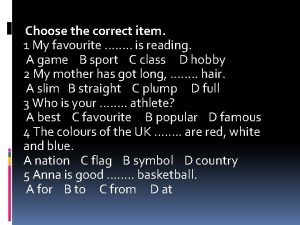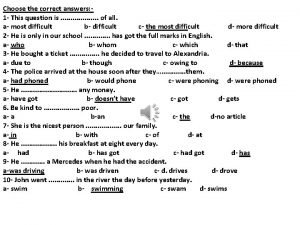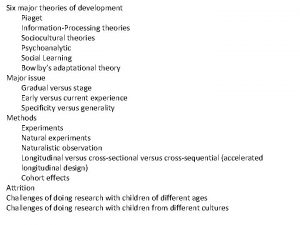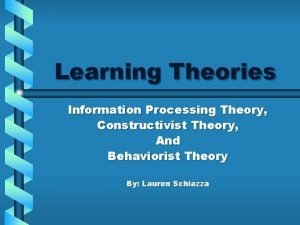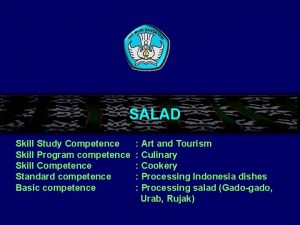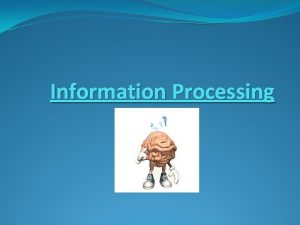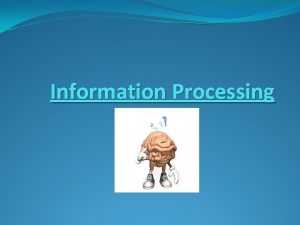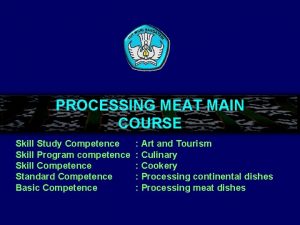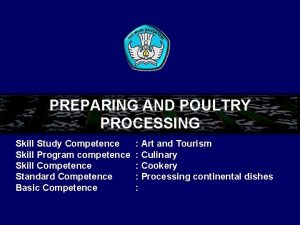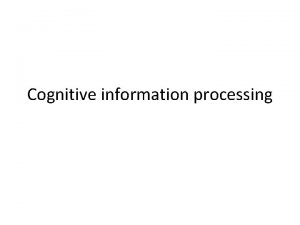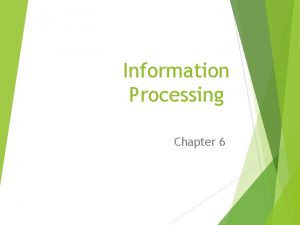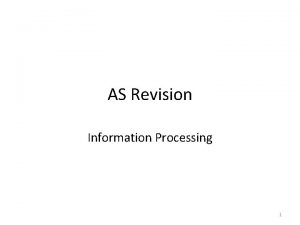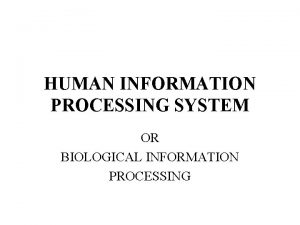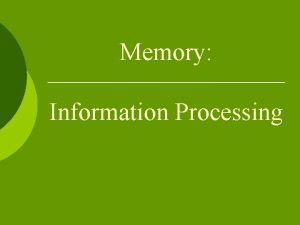Information Processing How do we choose a skill

















- Slides: 17

Information Processing How do we choose a skill to perform? What decisions do we need to make about performing a skill? Need to decide when to perform the skill Need to decide how fast to perform the skill All depends on what is going on around you

• In sport we have to analyse bits of information really quickly • What we see feel, hear etc • This information has to be processed • Hence ‘Information processing’

This section. . • Process of information though senses/ selective attention • Memory • Decision making • Response time and anticipation • Motor programmes and sub routines • How can we make our information processing systems more efficient?

Information Processing Model INPUT DECISION MAKING FEEDBACK OUTPUT

Input • Your senses provide you with information (input) • These can be sounds, pictures, sounds. • The information that comes from the environment that surrounds the performer. This information is called the display. • The brain has to decide what the information being received from the environment represents. • This is called the stimulus identification stage. • The other stages in decision making are: • RESPONSE SELECTION (deciding how to respond) and RESPONSE PROGRAMMING (selecting a response). Input Stimulus identification Response selection Response programming Output

Perception The performer must make sense of the information being displayed. The information helps us decide how to act 1. Comes from environment 2. Comes from memory of previous relevant situations Information from the external environment e. g vision and hearing Information from the internal environment (proprioceptive information) e. g body awareness Proprioception has three components: Touch- tactile sense that detects pressure, pain, temperature. Equilibrium- balance, tipping, turning, inverting. Kinaesthesis- provides information about the state of contraction of muscles, tendons or joints.

Perceptual Mechanism How do we identify a stimulus? DETECTION, COMPARISON, RECOGNITION (DCR process) Detection: the process of the registering of the stimulus by the sense organ Comparison: the process of referring the stimulus to memory, to compare it to previously stored stimuli. Recognition: the process of finding corresponding stimuli in the memory. During sport, we will be receiving a huge amount of information from our senses. There is so much that we can not detect, compare and recognise it all… https: //www. youtube. com/watch? v=Ahg 6 qcgoay 4 Simply put, the perceptual mechanism: Receives information/stimulus is from/display By the sensory organs; Filters out of information; Makes sense of the information

Selective attention Selective Attention • Ability to select relevant information from irrelevant information • Concentrate on relevant information • Prevents overload of information Amount of information presented to you will depend on experience of skill If new/ beginner- lots of information= overload If experienced- you automatically filter out the irrelevant stuff We focus on just a few of the millions of stimuli

Selective Attention • Experienced cricketer • Ignores majority of information and concentrates on flight of ball automatically • Detects relevant stimuli quicker without thinking= improved stimulus identification

Poor selective attention • A skill may break down at the input stage due to poor selective attention. • This will happen if…. - there is too much information (information overload) -The performer is unable to focus -The performer loses concentration -The performer focuses on irrelevant information

Improving Selective Attention 1. Increase the intensity of the stimulus (e. g colour of the ball) 2. Motivate the performer 3. Refer to past experiences (transfer) 4. Cue identification- direct them to a cue 5. Learn to ignore irrelevant stimuli (practise with distractions) 6. Make the stimulus meaningful/ unique (wave goodbye to basketball) 7. Mental rehearsal 8. Relevant practice

Recap 1. The information that comes from the environment that surrounds the performer is called what? The display 2. Response selection is… Deciding how to respond 3. Making sense of information is called…. Perception 4. Information comes from two places: Internal environment and external environment. 5. DCR process stands for Detection, Comparison, Recognition 6. Selective attention is… Filtering relevant information from irrelevant information

Information processing model • Simple IP Model INPUT DECISION MAKING OUTPUT FEEDBACK • There are other models that you need to know. Just remember- they are similar to this model but a bit more complicated!

WELFORD’S MODEL Extrinsic feedback Intrinsic feedback Effector mechanism-The brain function that is responsible for the organisation, initiation and control of the motor programme. Effector mechanism Perceptual mechanism Sensory mechanism Sense organs receiving information from the display Perception Internal Sensors Sensory Mechanism. Touch, Kineasthesis, Equilibrium Short Term Store Decision Making Long term store DCR Process Lasts up to 30 seconds Effector Control e. g played them before Short term sensory store- large capacity temporary store for all incoming sensory info. Filters information (selective attention) E f f e c t o r s Muscular system. Carry out MP

Put these in order according to Whiting’s Model Sense organs receive or detect stimuli vision/audition/ kineasthesis e. g eyes see ball coming Muscular system- muscles move to catch the ball Input from display e. g players/ ball Effector mechanism Transfers information from the brain to muscles e. g sent via nervous system to limbs Decision making - involves memory or DCR process. E. g decision to move hands to catch the ball Perceptual Mechanism (interpreting information, selective attention. E. g recognise the object as a ball/focus on ball Response end product or movement or outcome e. g ball is caught

Input from display e. g players/ ball Sense organs receive or detect stimuli vision/audition/ kineasthesis e. g eyes see ball coming A practical example Perceptual Mechanism (interpreting information, selective attention. E. g recognise the object as a ball/focus on ball Decision making - involves memory or DCR process. E. g decision to move hands to catch the ball Effector mechanism Transfers information from the brain to muscles e. g sent via nervous system to limbs Muscular system- muscles move to catch the ball Response end product or movement or outcome e. g ball is caught

Recap Create a poster for Welfords Model. Homework 1) Complete poster 2) Complete the exam questions on information processing
 Hard vs soft skills
Hard vs soft skills Choise the correct item for
Choise the correct item for Answer
Answer Top down procesing
Top down procesing Bottom up processing vs top down processing
Bottom up processing vs top down processing Top-down processing vs bottom-up processing
Top-down processing vs bottom-up processing High boost filtering matlab
High boost filtering matlab Primary food production
Primary food production Point processing in image processing example
Point processing in image processing example Histogram processing in digital image processing
Histogram processing in digital image processing Parallel processing vs concurrent processing
Parallel processing vs concurrent processing Neighborhood processing in digital image processing
Neighborhood processing in digital image processing Image processing
Image processing Gonzalez
Gonzalez Top down procesing
Top down procesing What is interactive processing
What is interactive processing Information processing theory by atkinson and shiffrin
Information processing theory by atkinson and shiffrin What is the information processing theory
What is the information processing theory

